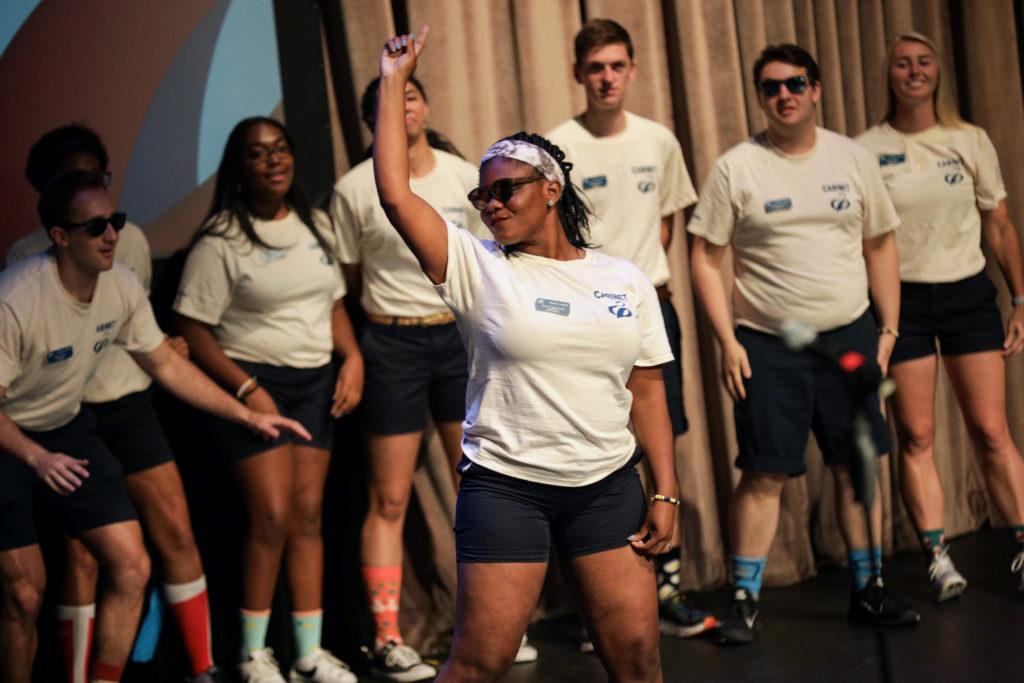The Class of 2023 will attend orientation just days before they walk into their first class.
First-year orientation will be held over five days in late August this year, replacing the University’s six-session summer program previously held in June and July. The move, which also changes the name of the event from “Colonial Inauguration” to “new-student orientation,” will bring the entire freshman class together for one session before the start of the semester.
“We can get the entire community together,” Dean of Admissions Costas Solomou said. “We want to be fully comprehensive with every student who calls GW their home.”
Students will move into their housing assignments on Aug. 21, the first day of orientation, and attend a kick-off event later that evening. The next two days include family programming, and officials said they are still planning community-building events for the new class, which could include a class picture.
First-year students will also participate in Freshman Day of Service and their class’ convocation ceremony on the last two days of orientation instead of participating in those events after the semester starts.
Officials enlisted the help of more than 100 students, faculty and staff to plan the new orientation. Volunteers were divided into seven planning committees – like academic advising services, student and family programming and pre-orientation activities.
Solomou said officials decided to change orientation after analyzing peer schools’ models and reviewing research that had previously been conducted about CI.
Nine of the University’s 12 peer institutions – including Georgetown, Tulane and Syracuse universities – host orientation during the days leading up to the first day of school.
Solomou said a fall orientation is also more financially viable for families that can’t afford to travel to and from campus multiple times before students move in. Faculty also preferred fall orientation because they are more likely to be on campus and can meet with students before the semester begins, he said.
“We did a decision-making process and said, ‘OK – here’s what CI looks like now. What if we were to enhance CI and move to an August model?’” he said. “So we looked at a couple of different scenarios and through all of this gathering of data, it led us to this final decision.”
Previously, first-year students signed up for one of six two-day orientation sessions. Officials most recently updated CI two years ago when they made sessions more frequent and axed family programming.
Orientation also featured diversity training for the first time last summer after a racist Snapchat incident rocked campus in February.
Solomou added that officials plan to collect feedback on and evaluate the success of the new orientation model, either through a survey of first-year students or in-person meetings.
Laurie Koehler, the senior vice provost of enrollment and the student experience, said that by allowing international and transfer students to participate in the same session as domestic students, all groups will feel more integrated with their class. Previously, transfer and international students attended a “shorter, not as comprehensive” CI session in August, she said.
“By bringing the class together in a shared experience for several days, we’re facilitating an opportunity for students from all different places and all different backgrounds to get to know each other from day one,” she said.
Koehler said the decision to change orientation also coincided with the launch of the Office of Enrollment and the Student Experience over the summer, allowing administrators to hone in on a “student-centered” focus in “everything we do.”
Improving the student experience has been a major focus of University President Thomas LeBlanc’s two-year tenure.
Student Association President Ashley Le, who discussed changing the orientation model with officials, said the changes are “necessary” because students will feel a sense of community among their peers as soon as they step on campus.
Le added that the move will aid low-income students who may not live in the D.C. area and can not afford multiple trips to campus before classes begin.
“It means a lot to know that the University is doing their best to adjust and that they are more inclusive to students from all backgrounds in all of their programming,” she said.
Higher education experts say that while it may take years to evaluate the impact of the changes, the switch will alleviate traveling costs for families and concerns about finding classes and professors before the first day of school.
Cristiana Quinn, a counselor at College Admission Advisors, a company that offers high school students college application counseling, said the change is “nothing but positive” because low-income families often stress over the cost of traveling to campus for a couple days and paying for another trip when the semester begins.
She added that a fall orientation model works better for students who have jobs during the summer and may not be able to take time off.
“Students are only employed for a short period of time, and employers don’t want them to take more days off in the middle of the summer,” she said.
Justin Bruce, the assistant director of orientation and first-year programs at the University of Rochester, said a fall orientation is a way to “develop the class community from the get-go.” He said having an extra few days on campus before courses start allows students to find professors’ offices or classrooms.
“I think the goal is to create as easy a process for any student,” he said.





